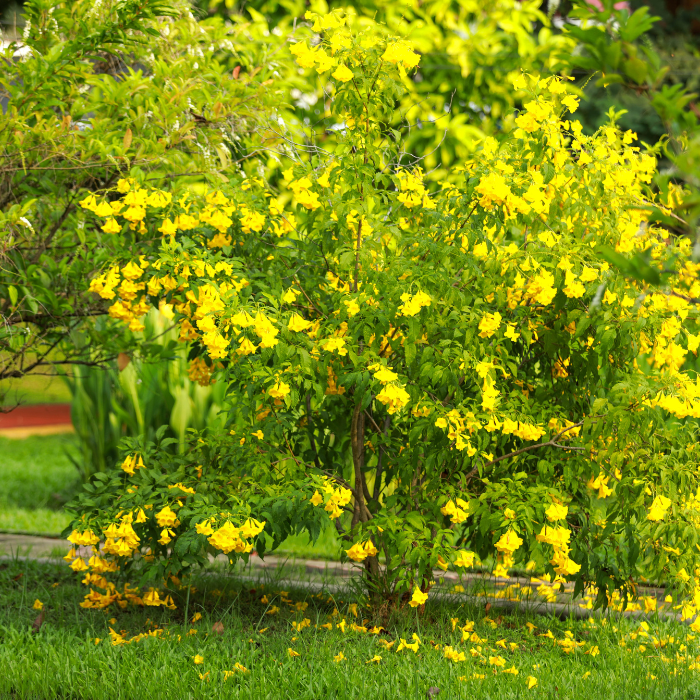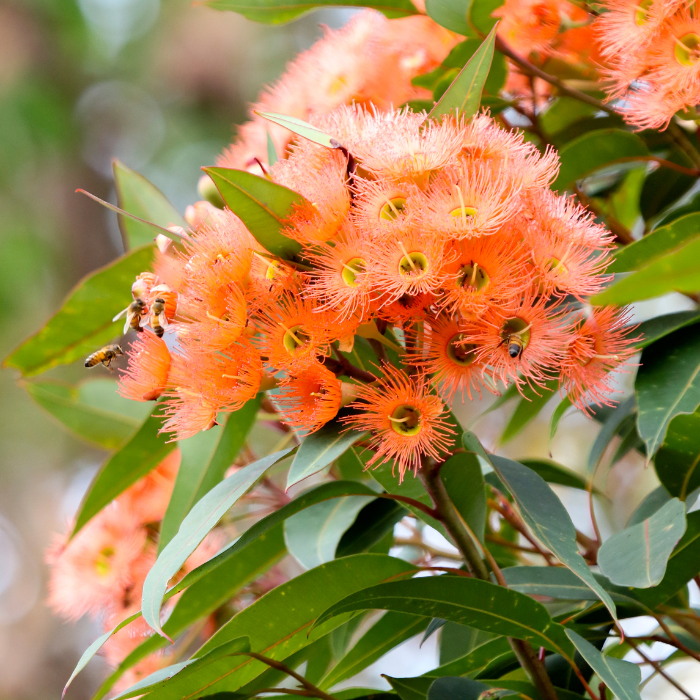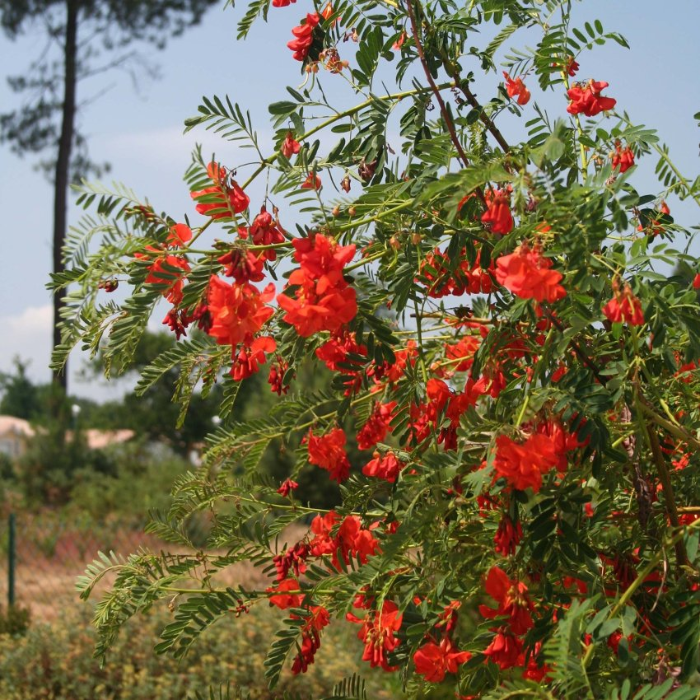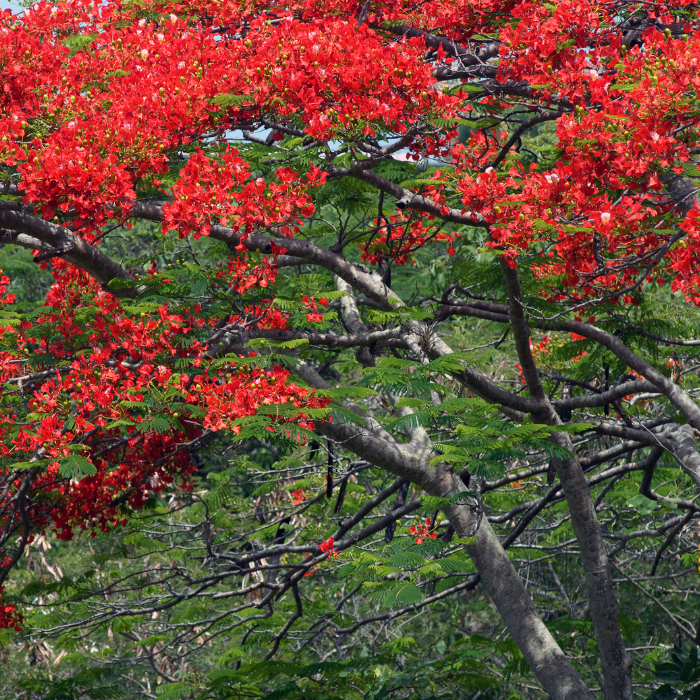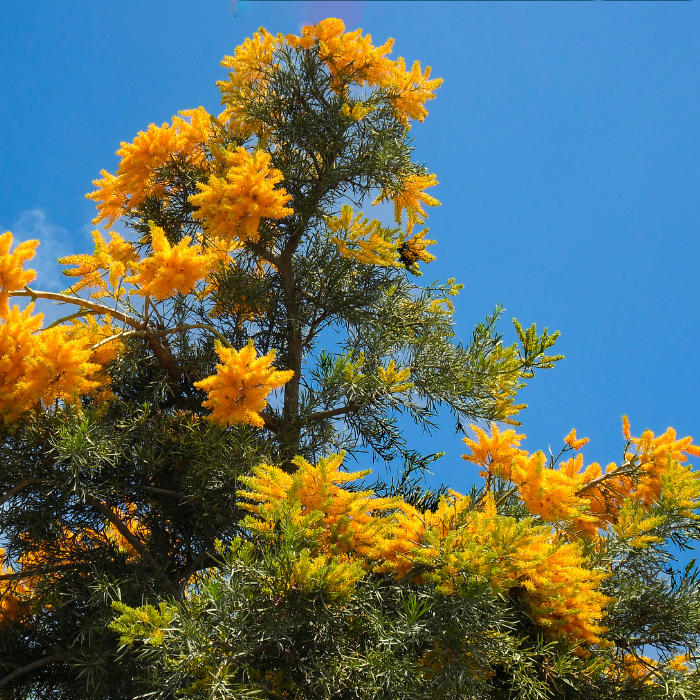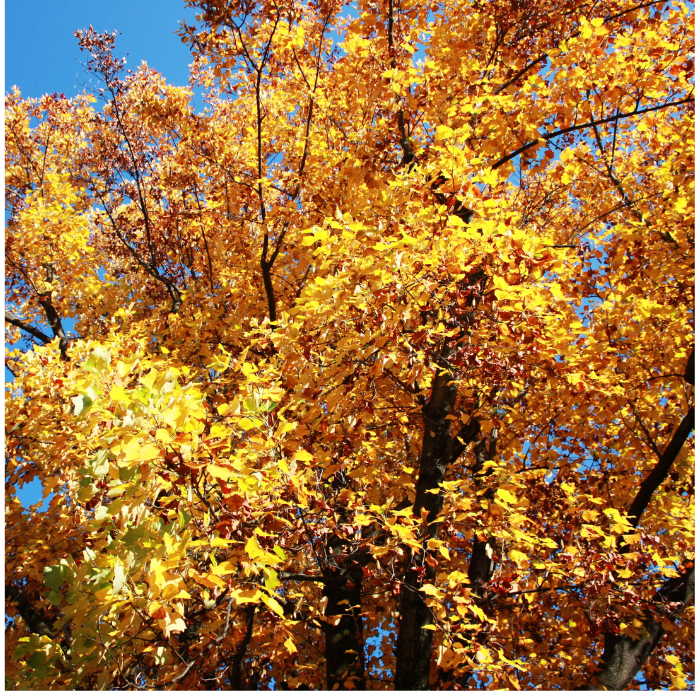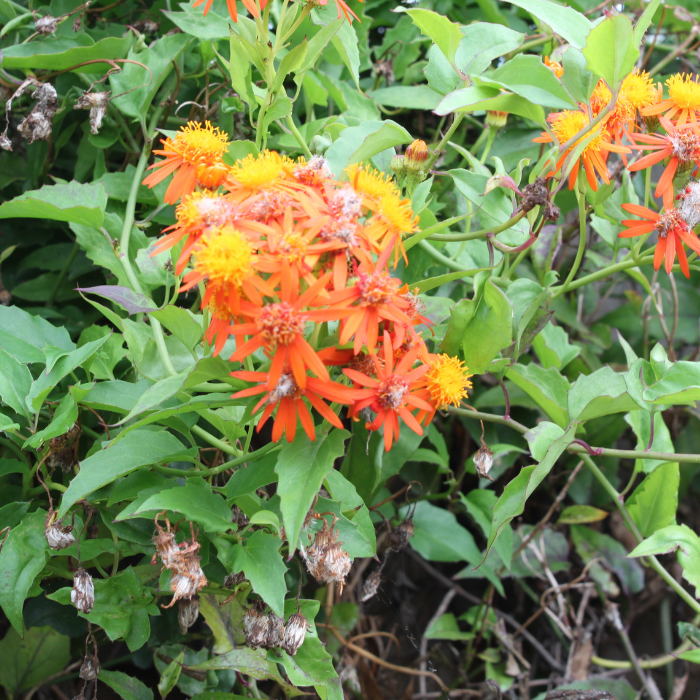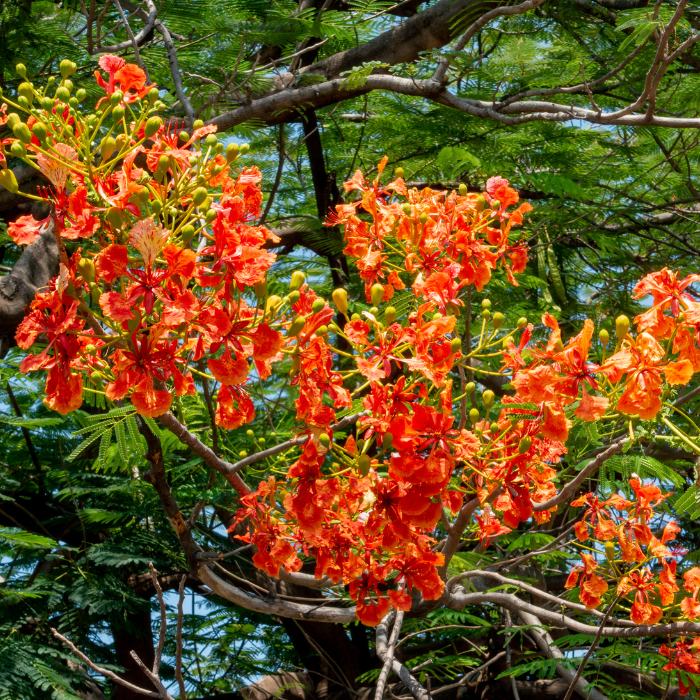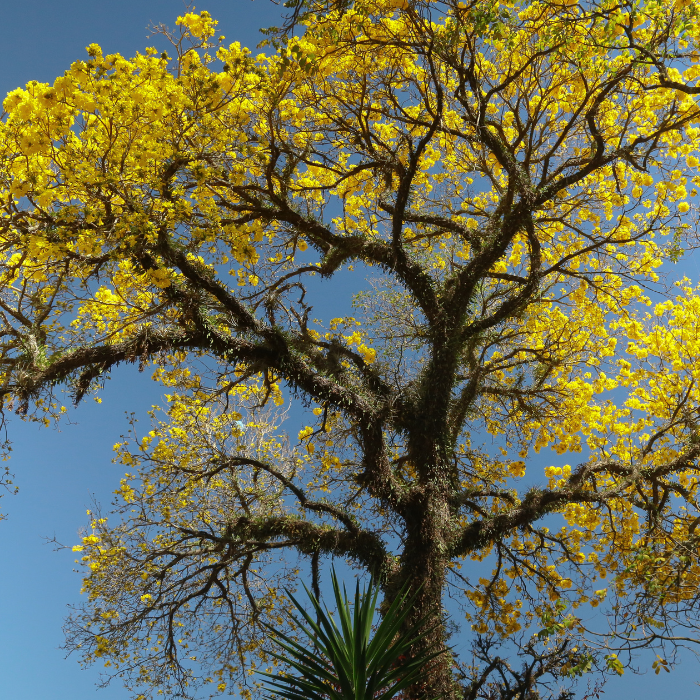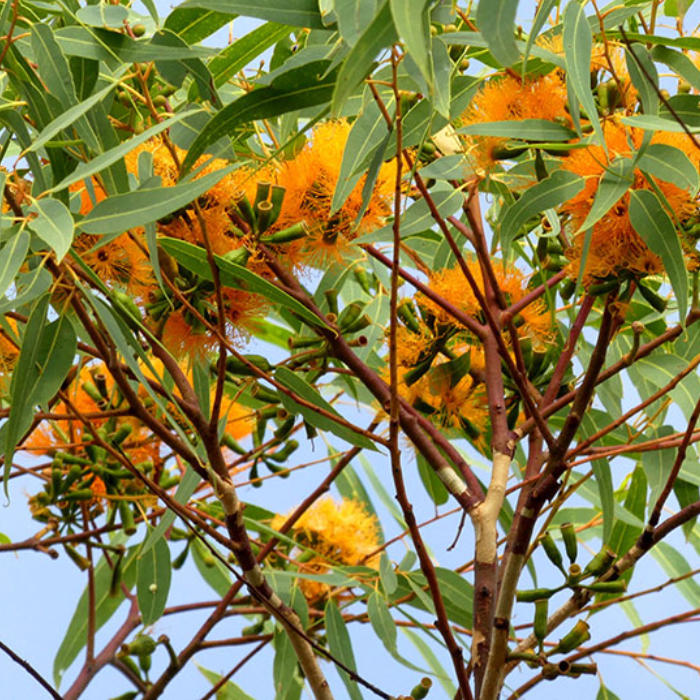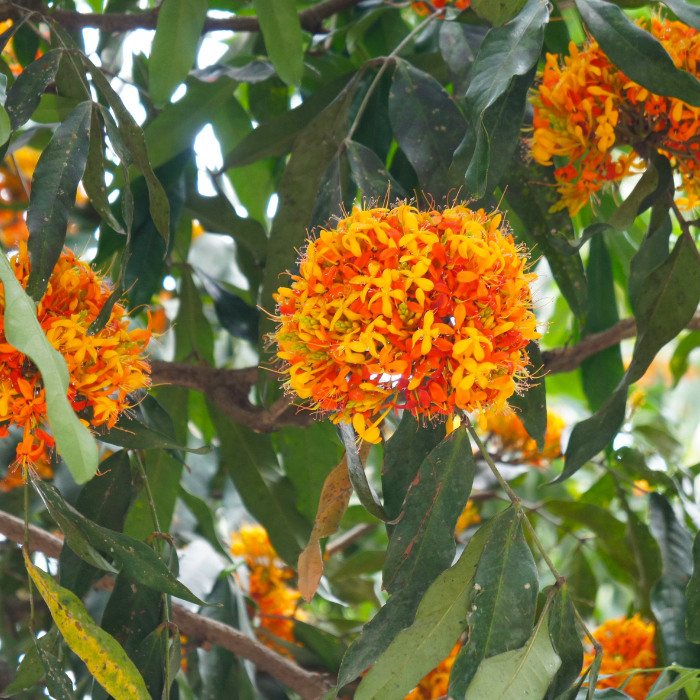
The beauty of a garden lies not only in its greenery, but also in the bursts of colour that liven up the place. Unfortunately, in the UK, where the weather is often unpredictable, finding trees with captivating orange blossoms can be tricky.
Yet, it’s still possible to incorporate that touch of warmth and vibrancy into your garden that orange flowers bring.
In this blog post, we’ll unearth 17 orange flowering trees that you can grow in your garden. Some may require more maintenance than others, but there’s something here for everyone.
Small Orange Flowering Trees
1. ‘Orange Jubilee’ Elder Tree (Tecoma stans ‘Orange Jubilee)
Elder trees typically have showstopping yellow flowers, but not this variety – this one boasts peachy orange blooms. But they still sport the characteristic bell shape that we love about Elder trees, don’t you worry!
This is considered a shrub but can be trained as a small tree, so it’ll sit nicely in a tight spot in a small or medium-sized garden. Unfortunately though, it doesn’t like the cold, so it doesn’t do too well in our cold winters. But that doesn’t mean you can’t grow it here in the UK – just pot it up and bring it inside before the first frost!
2. Baby Orange Flowering Gum (Corymbia ficifolia ‘Baby Orange’)
When it comes to dwarf orange flowering trees, the Baby Orange Flowering Gum is the best of the best. But, let’s be frank, it doesn’t have much to compete with! Nevertheless, it’s a beautiful dwarf tree, growing 3 metres in both width and height.
It produces a plethora of richly-coloured orange flowers that cover its dense canopy. These typically reveal themselves in summer but sometimes pop up unexpectedly in warm weather at other times of the year.
3. Scarlet Wisteria (Sesbania punicea)
The Wisterias we have over here in the UK tend to have purple or white flowers, but orange?! If you’re already a Wisteria fan like me, you’ll love this one. It has everything we know and love about Wisterias – the thin, oval-shaped leaves and the pea-like flowers, but the Scarlet Wisteria flaunts fiery colours rather than the delicate shades we’re used to.
While the Scarlet Wisteria is usually considered a shrub, it can be trained as a small tree, so it makes the list!
READ NEXT: Wisteria Care Guide: How to Grow These Beautiful Climbers
4. Scarlet Sterculia (Sterculia colorata)
The Scarlet Sterculia is a medium-sized tree from Southeast Asia. One interesting quality about this tree is its caudex – its stem swells at the base, providing the plant with a space for water storage. This acts as a lifeline for the plant, as it typically grows in arid environments where water is scarce in its native habitat.
Unfortunately, it won’t grow well outdoors here in the UK because it favours a much warmer climate, but it makes an excellent houseplant, so don’t give up hope just yet!
Big Trees With Orange Flowers
5. Champak (Magnolia champaca)
Champak is an extremely tall (50 metres and over) evergreen tree that we love in the UK. So much so that we’ve given it various names – “Joy Perfume Tree,” “Yellow Jade Orchid Tree,” and “Fragrant Himalayan Champaca.”
As you may have spotted from Champak’s scientific name, it’s in the Magnolia family. Its ancestry is obvious once you take a look at its gorgeous, apricot-coloured flowers that sport the characteristic Magnolia shape and size.
6. Red Silk Cotton Tree (Bombax ceiba)
You may have seen the Red Silk Cotton Tree on our list of Red Flowering Trees – but here’s why. Sometimes, the Red Silk Cotton Tree’s flowers show off pure red colouration. But on other occasions, the outside of their petals have an orange tinge, giving the appearance of orange flowers.
This is one of the tallest trees on our list, standing at an immense height of 22 metres. So, if you want to include this tree in your garden, you may have to make space for it!
7. Bronze Shower Tree (Cassia moschata)
One of the most elusive tall orange flowering trees is the Bronze Shower Tree. If you have ever seen this tree, you couldn’t miss it, yet the likelihood of you spotting it is low. Not much is known about this tree – its native range is supposedly Central and South American and Cuba, yet its natural habitat is mostly a mystery, although it’s been spotted in flooded forests and near other water sources.
It grows 20 metres tall and shows off glorious, bronze-coloured blooms that hang from the branches, giving it lots of ornamental potential.
8. Western Australian Christmas Tree (Nuytsia floribunda)
The Western Australian Christmas Tree produces vivid orange flowers during the Austral summer season, hence the name. Unlike any other on this list, the Western Australian Christmas Tree is hemiparasitic – it takes nutrients and water from host plants using its underground root networks.
While this tree doesn’t seem to do serious damage to the plants it is attached to, its root networks are substantial, with some known to grow as long as 150 metres – the longest root network ever uncovered!
9. Silky Oak (Grevillea robusta)
Silky Oak is an evergreen tree that grows up to 22 metres tall. As the tree matures, it begins to produce a profusion of vivid orange flowers on one-sided spikes. When this contrasts with the backdrop of olive-green leaves, it creates a stunning display.
The best gardens to grow Silky Oak are Mediterranean and xeriscape gardens, but it’ll do well in just about any space that needs a pop of colour. But bear in mind that you’ll need a decent amount of space for this one!
Evergreen Orange Flowering Trees
10. Fragrant Tea Olive (Osmanthus fragrans f. aurantiacus)
The Fragrant Tea Olive is a tree with many names, also often called the “Sweet Olive” and “Orange Sweet Olive,” which goes to show just how popular this plant is. It’s a small tree or medium-sized shrub that is relatively hardy, growing well in both full sun and partial shade, as well as drought once it has become established.
But it’s not really the Fragrant Tea Olive’s hardiness that makes it so popular – it’s its flowers. In autumn, it blooms clusters of delicate tangerine-orange flowers with a glorious apricot-fresh fragrance.
11. Mexican Flame Vine (Pseudogynoxys chenopodioides)
The Mexican Flame Vine’s name would suggest it doesn’t belong on this list. However, this plant is trainable as a tree, too – so you can choose whether you want a climbing vine or a small tree. That’s a win-win in my eyes.
I particularly love this tree because of the energetic shade of its petals. If you’re familiar with Dulux’s popular paint colour, Moroccan Flame, then you’ll know exactly what I’m talking about. The Mexican Flame Vine’s flowers are made up of several thin petals that bend back toward the stems to reveal just as brightly coloured puffs of seed.
12. Geiger Tree (Cordia sebestena)
The Geiger Tree is a small, shrubby tree that’s endemic to the American tropics. It forms a thick, round canopy of branches and vibrant orange funnel-shaped flowers that look a little like Petunias but with more defined petals. The tree grows to around 9 metres tall and does best in full sun or partial shade.
It’s a hardy plant that’s capable of tolerating strong winds, coastal conditions, drought, and nutrient-poor soil, so it’s an ideal plant for beginner gardeners who want plants that need minimal maintenance but that have maximum impact.
Tropical Trees With Orange Flowers
13. African Tulip Tree (Spathodea campanulata)
The African Tulip Tree is the perfect addition if you have a big garden and are looking for a large tree for your space. It can grow over 18 metres tall in tropical Africa and grows to around 12 metres in places like San Diego. While it’s not common to see an African Tulip Tree in the UK, it’s possible to grow one in the warmer regions if it’s in a conservatory or greenhouse. Of course, in these conditions, it’s unlikely to reach its usual lofty height!
14. Jamaican Rain Tree (Brya ebenus)
The Jamaican Rain Tree is a shrub or small tree that grows up to 6 metres, making it the ideal choice for a fiery pop of colour in a small or medium-sized garden. It has gorgeously ornamental arching branches which – in the warmer seasons just after the rain stops – are adorned with a profusion of yellow-orange flowers that attract butterflies and, in its native region, hummingbirds.
READ NEXT: The 33 Best Trees For Small Gardens
15. Flame of the Forest (Butea frondosa)
Frame of the Forest is a tropical tree native to South Asia and Southeast Asia. This tree is noted for its impressive floral display, showing off big red and orange flowers that grow up to 2 inches long. While it’s appreciated as an ornamental plant worldwide, it’s particularly special to Hindus, who worship this tree as sacred.
If you want to create a Mediterranean garden, the Flame of the Forest is your top choice – it loves well-drained soil and is almost completely pest and disease-free.
16. Scarlet Gum (Eucalyptus phoenicea)
Sweet Gum is the Eucalyptus tree of the tropics and subtropics. It’s a medium-sized tree, growing to around 12 metres in optimal conditions, and has a slender trunk that sports a yellow-brown colour.
Whenever anyone sees Sweet Gum, it’s the flowers they’re talking about. These unique, pom-pom-shaped flowers not only draw our attention, but that of the birds and insects too. This quality makes it a highly beneficial tree for wildlife.
17. Ashoka Tree (Saraca asoca)
The Ashoka Tree is a beautiful ornamental plant that graces gardens with clusters of fragrant, orange-yellow blossoms. Its elegant, fern-like leaves complement its vivid flowers. In India – its native region – the Ashoka Tree holds immense cultural and religious significance and is often associated with various Hindu and Buddhist traditions. In Buddhism, it’s believed to be the tree under which Queen Maya, the mother of Buddha, gave birth.
FAQs
What tree has orange flowers UK?
In the UK, several trees can produce orange flowers, though they may not be as common as trees with other flower colours. One tree with orange flowers that you may find in the UK is the Rowan Tree (Sorbus aucuparia), also known as the Mountain Ash or European Rowan. While the Rowan Tree tends to produce clusters of small, white flowers in late spring to early summer, these flowers can sometimes have a slight orange tint, turning them a pastel orange colour.
What is the name of the orange blossom tree?
The “orange blossom tree” typically refers to the Sweet Orange tree (Citrus × sinensis), a citrus tree known for its fragrant and beautiful orange blossoms. The orange blossom flower is a small, white, and highly fragrant flower that appears in the spring, usually between March and April. These delicate blossoms are usually five-petaled and have a sweet, citrusy, floral scent with notes of honey and a hint of spice.
What is the orange flower that opens and closes?
The orange flower that opens and closes is the California poppy (Eschscholzia californica), which exhibits a unique behaviour where its petals open during the day and close at night or in cloudy weather. The California poppy is a wildflower native to the western United States, particularly California.
What is the orange flowering shrub in spring?
One of the commonly seen orange-flowering shrubs in the UK during the spring is the Chaenomeles japonica, commonly known as Japanese Quince or Japonica. It’s a deciduous shrub that produces vibrant orange-red or orange-pink flowers in early spring, typically from March to April. These flowers appear before the shrub’s leaves emerge, creating a striking display of colour.
If you loved learning about orange flowering trees and want to create a dramatic fire garden, you have to check out our list of 35 Different Types of Yellow Flowering Trees!
